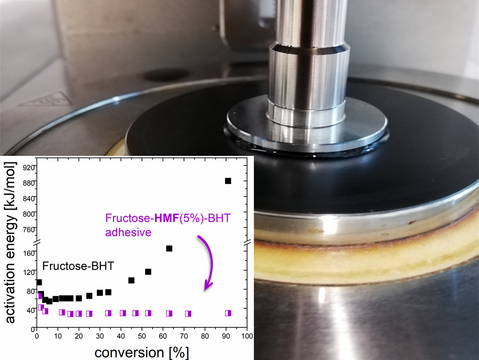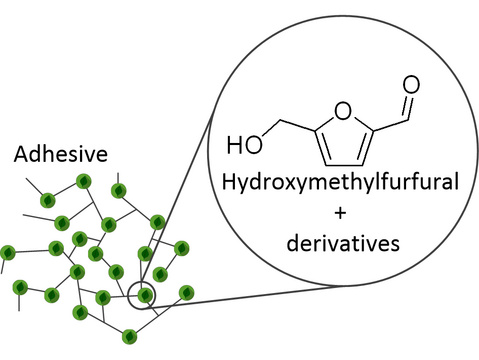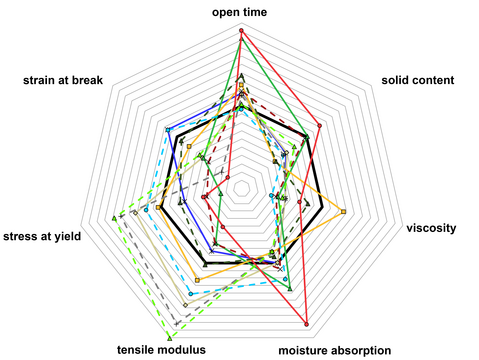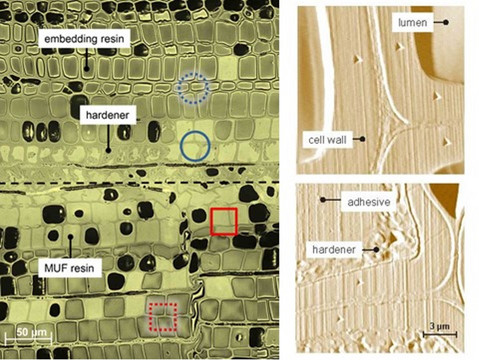Adhesion
Description
The research group on adhesion is concerned with the fundamental understanding of all aspects of the bonding of solid wood and wood particles of different sizes. The research activities include the characterization and modification of bonding surfaces, interfaces and adhesives. Of particular interest are, among other things, the development of formaldehyde-free systems and adhesives based on renewable raw materials, the effect of additives, adhesive-bonding interactions, bonding processes for (wood-based) products and to the performance of adhesives.
Contact: Anita Tran and Johannes Konnerth
Research and publications

Rheological studies on carbohydrate HMF amine adhesives
Improvement of the adhesive properties of various plant proteins by alkaline hydrolysis
Wheat extenders in condensation resins for plywood production

VIDEO: This video presents the reTHINK.PRO.AD project
In this project we produce adhesives from plant proteins and study how their adhesion and processing properties can be improved by mechanical treatments.
Theses (since 2015)
Dissertations
Andrej Fasalek (ongoing): Optimised strand and panel adhesion for the production of new wood-building products.
Ritika Malik (ongoing): Novel protein-based wood adhesives.
Sarah Suarez (ongoing): Sensing with functionalised adhesive bondlines.
Latifeh Nasseri (ongoing): Curing kinetics of adhesives for particleboard panels.
Wilfried Sailer-Kronlachner (2023): Development of carbohydrate wood adhesives.
Catherine Thoma (2023): Carbohydrate-based adhesives for wood bonding.
Elena Averina (2023): Protein-based adhesives for wood bonding.
Peter Bliem (2022): The role of adhesive processing in the bonding of wood-based materials.
Christoph Winkler (2021): Process and material features influencing piezoresistive wood adhesives (FH Eberswalde)
Elfriede Maria Hogger (2020): Engineering of resin properties in plywood production – Focusing on cold tack analysis and resin modification by additives.
Stefan Bockel (2020): Structural bonding of European beech wood (Fagus sylvatica L.) with polyurethane adhesives – A study investigating various aspects of wood-adhesive interactions with a focus on wood extractives.
Axel Maximilian Rindler (2019): The significance of bond region micromechanics on the moisture related dimensional stability of thin wooden multi-layered panels.
Pia Solt (2019): Alternative adhesive systems for wood panel application – Bio-based and Formaldehyde-free Adhesives.
Sabine Herzele (2019): Interfaces between lignocellulosic fibers and synthetic polymers.
Bernd Lütkemeier (2017): Kleben von modifiziertem Vollholz (Universität Göttingen)
Masoumeh Ghorbani (2017): Lignin-based Phenolic Adhesives for Wood-based Materials.
Eike Alexander Mahrdt (2016): Mikroskopische Charakterisierung der Klebstoffverteilung in Holzwerkstoffen – in Bezug zu mechanischen Holzwerkstoffeigenschaften.
Master theses
Martin Wette (ongoing): Mechanische Vorbehandlung von Proteindispersionen für den Klebstoffeinsatz.
Julian Schnepps (ongoing): Erstellung eines mathematischen Modells zur Berechnung und Ermittlung des maximalen Biegemoments von keilgezinktem Vollholz in Abhängigkeit der Querschnittsform und der maximalen Querschnittsfläche.
Günther Kneidinger (2019): Interaktion und Adhäsion zwischen lignozellulosischen Regeneratfasern und synthetischen Polymeren.
David Alexander Obernosterer (2018): Verbesserung des Brandschutzes im konstruktiven Holzbau.
Peter Bliem (2017): Characterization of foam properties of 2C-polyurethane for wood bonding.
Max Weissmann (2017): Herstellung und Charakterisierung eines durch mikrofibrillierte Cellulose verstärkten Melamin-Harnstoff-Formaldehyd-Schaums.
Andreas Schindler (2016): Modifikation von Aminoplasten in Holzwerkstoffen.
Lorenz Pfungen (2015): Lignin Phenol Formaldehyde Wood Adhesives.
Maria Krahofer (2015): Characterisation of lignin-phenol-formaldehyde wood adhesives prepared from different types of lignin.



